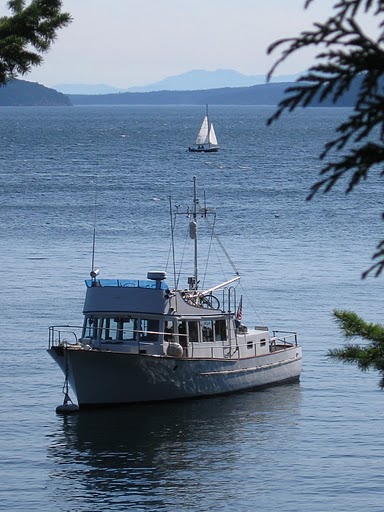- Industrial based computer running WinXP
- GPS receiver
- AIS Transceiver
- SeaClear software
- Free NOAA charts
Both SeaClear and US charts are available for free. There is another free charting software that has improved over the years called OpenCPN. When I first assembled our system OpenCPN had very few features, so I settled on SeaClear. OpenCPN in now rather complete, and it has the advantage of supporting both Raster and Vector charts. I may change to it in the future as the future is ENC vector charts.
But for now, we use SeaClear and it works very well for us. (Update: we did play with openCPN a bit, and it worked by there was a very noticeable lag in trying to zoom and scroll the display. So we want back to SeaClear which is crisp in its display updates)
On the computer: We are using an industrially rated (wider operational temperature range) board vs. say a laptop or desk side PC. Our system is built around a MSI IM-945GC Mini-ITX board. It uses an Intel Atom-330 dual core CPU, 2GB of memory and a 32GB SSD. It provides us with all the computing power we need for navigation, and even DVD playback. Unfortunately the IM-945 is out of production, which is sad as this board has a LOT of RS-232 ports making it easy to connect to NMEA-0183 devices (ala GPS, AIS, VHF, etc..) Or well, there are some other boards out there – and of course one can always use USB dongles.
For the OS, we are using WinXP with SP-3. One very key choice is ALL networking functions have been disabled on this system. In this way, Windows cannot ‘reach out’ and ‘helpfully’ auto-download updates. This has gone a long way towards making sure this system is stable and reliable.
One other hint: just because a system says 12V DC input does not mean it can handle the wide range of voltage seen in a boat, maybe from 10v-15v. There are some computers and power supplies out there that can directly connect to the battery - look for "Automobile" computers. Our solution was not one of them. In order to get a stable 12v supply for the computer I used surplus HP F1064A dc-dc converters. These are very well designed automobile adapters and provide a stable 12v out while adapting to the wide input voltage. Often found on eBay for under $10 one will not find a better value along with that great old-school HP design approach. I used two in parallel to get sufficient wattage (they are 45w each) to drive the navigation computer.
We are very happy with this. And have backups on one of our laptops. We tend to use the laptop for route planning, then transfer the waypoints and route information to the navigation computer via USB flash drive. And then again to the standalone GPS (in case the computer fails). Plus, when motoring along we still do paper chart monitoring – mostly Kristi – she follows our progress using charts on the table.
Some links:
Computer and case: www.logicsupply.com/
Custom front pannel: www.frontpanelexpress.com/
NOAA Charts: www.nauticalcharts.noaa.gov/staff/charts.htm
There are of course other chart plotter solutions, both PC based as well as dedicated. And as one gets into very integrated systems they start to include feature like Radar overlays, integrated tide and current, and such. But for us: Dedicated devices (not everything goes down at one), and low cost / reliable solutions are what we have settled on. Plus, this approach (e.g., NOT connecting the autopilot to the chart-plotter) means we need to STAY ENGAGED during the operation of the boat.
Something else that is a 'Things That Work . . . '
Note: Check out this post for more details around the hardware: http://mvvikingstar.blogspot.com/2012/04/hardware-considerations-for-pc-based.html


oh Neat! Thanks for sharing your Navigation set up. I believe most of our nav stuff will be the last thing we buy as technology is always improving, but in the meantime I love to see what others are currently doing.
ReplyDeleteWhen Tate and I first discussed sailing, the idea was to use paper charts only, and maybe a handheld. But since we actually got and use the handheld... while we still always have a paper chart, it is so much nicer with the GPS.
A chartplotter is in our future.
Thanks for sharing your nav set-up. I have been using SeaClear for 3 years now on a laptop with all the problems that brings and your dedicated computer has me rethinking my system. I would enjoy an expanded blog on the selection of a simple, dedicated nav computer, especially the things to look for (and to avoid) if you're not a computer designer. Thanks too for the openCPN link.
ReplyDeleteThank you both, you have motivated me to create today's entry:
ReplyDeletehttp://mvvikingstar.blogspot.com/2012/04/hardware-considerations-for-pc-based.html
where I document the hardware for the computer.